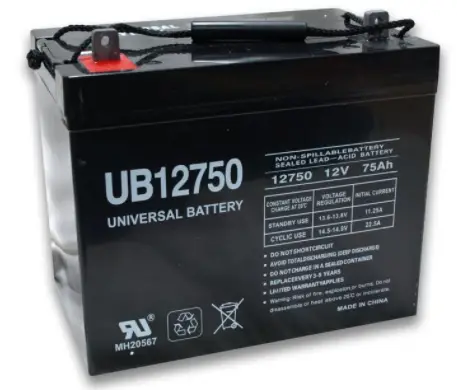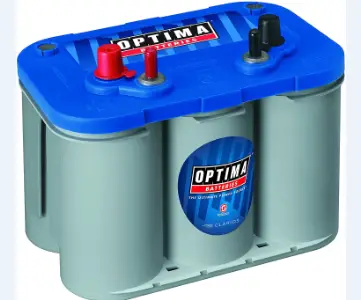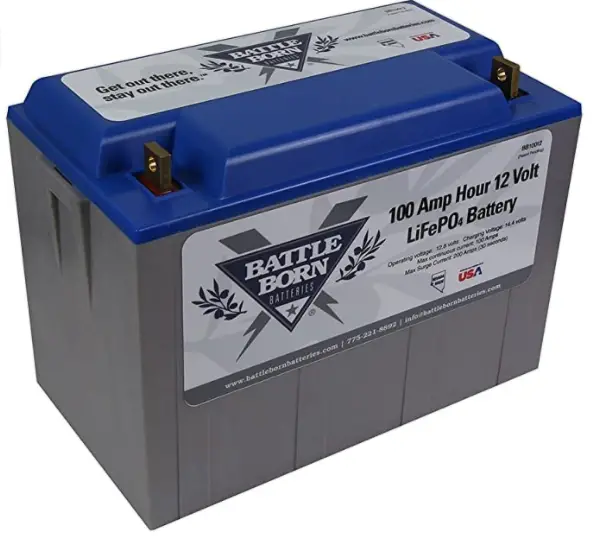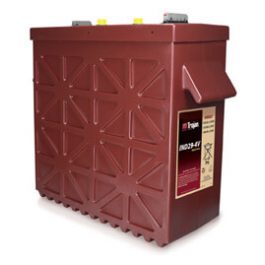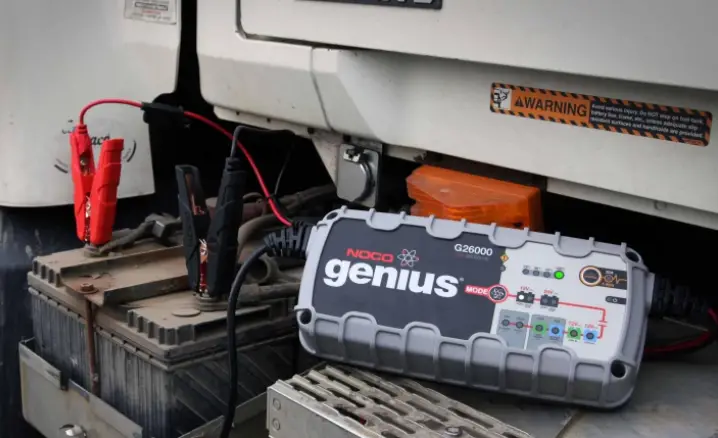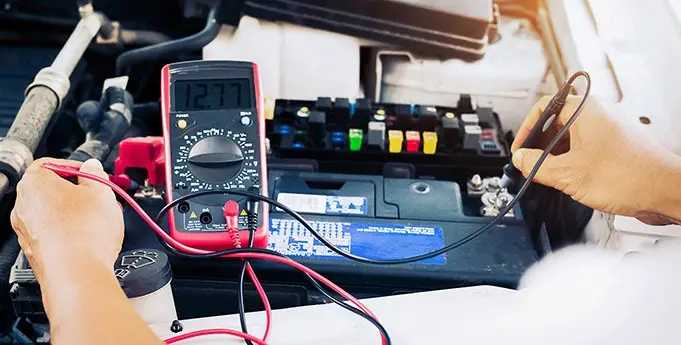In this buyer's guide, we gonna take a look at the best batteries for solar RV
There’s a lot of battery choices out there. That’s why we’ve made this guide to take you through the product selection for various weather and temperature conditions to keep your RV appliances and other devices working.
So let's check them out before your next road trip...
5 Best Batteries For Solar RV
Disclosure: All products have affiliate links to commission to support the website when you purchase
Why did we pick this one? From the company, Universal Power Group, comes one of their best batteries. The Universal 12V Deep Cycle Battery is a state-of-the-art battery that is non-spillable, meaning that it is sealed and requires no additional water throughout its life.
This is different from the flooded RV batteries because in the flooded batteries, additional water every week or so is required, but in order to reduce maintenance as much as possible with the AGM battery, the company decided to make it sealed.
What are users saying about this product?
Sealed tight- No dangerous and hazardous fumes can escape while the device is being charged- all of the gases, while the battery is being charged, are processed within the battery itself to prevent any leaks.the
Any Position - Make it convenient and easily transportable by air or ground without special handling or extra maintenance.
Charge and power- The device offers a float and cycle use- this includes the DC output voltage at 12 V which is convenient for a lot of devices that are of everyday use. Weighing in at almost 50 lbs, this small battery can hold up to 20 hours of battery power with a full charge. If want to learn how to measure your battery state-of-charge, check out our guide here.
Since the battery is tightly sealed, the stand-by discharge of the battery is rated to be less than three percent in a month! Lead acid is supposed to have one of the lowest standby discharges with about five percent a month, but it seems that this AGM deep cycle battery beats that.
Affordability- The battery offers a lot of features- with all of these features, one would expect the price to be higher than usual due to the low maintenance, but with just $160, this battery is great for dry camping or boondocking trip.
The company also offers a one-year warranty, just in case that the battery doesn’t work or breaks down before a year of purchasing it.
One of the few downsides that this product possesses is that due to the seal and the decreased maintenance, the battery life of the product might not last as long as other batteries- this is to take into consideration along with the cheap, reduced price of the battery.
Why did we pick this one? The Optima D34M BlueTop battery is designed to act as a dual-purpose battery, made for people who need a reliable, strong, and low-maintenance battery.
The deep cycle battery is made specifically for harsh conditions- ready to output electricity during long, bumpy roads, or even during storms that might leave damage on the battery.
The SpiralCell design that is produced by the company provides power from a cleanly generated source which makes the battery and the power that comes out of the battery safe for the users. Being great for rainy summers and rough winters.
What are users saying about this product?
SpiralCell Technology- Increased battery energy density & safety than normal batteries via individual spiral-wound cells to output greater power
Sealed up- Glass mat separates the gasses created when the battery is being charged to prevent acid leak for long term use.
This battery automatically controls and monitors critical tolerances, temperatures and the humidity within the environment, so that it doesn’t affect the charging and discharging process.
Tight Tolerance & Durability- Increased vibration resistance to withstand wiggling or bouncing up and down during rough road trips and conditions, and it gives the battery more efficient outputs
On a fully charged battery life, depending on how many devices are hooked up to the battery, it outputs about 55 hours of battery life which can be easily charged and increased with a few solar panels.
Why did we pick this one? Built by the company, Battle Born Batteries, the LiFePO4 Deep Cycle Battery is introduced with a premium technology known as Battery Management System or BMS.
The battery management system protects the cells of the batteries from the most common failures that occur often such as temperature volatility or even ground faults. The BMS regulars how much power that is being taken out of the battery and acts, kind of, like a shut-off system where the battery shuts itself off under unsafe operating conditions to protect itself and, most importantly, the user.
But that isn’t the only premium piece of technology that’s offered by the battery.
What are users saying about this product?
Premium technology- Unlike the traditional lead-acid batteries found commonly in the solar RV battery market, Battle Born’s LiFePO4 comes with lithium-ion batteries which consist of unlimited mounting capabilities and makes the battery cost-effective overall.
We know that the battery is a bit costly for those with a budget, but if you’re willing to spend a little extra, the company can guarantee their confidence in the product that generates from the battery.
The technology is also safer than lead-acid batteries as well which have no extra protection against ground faults which can cause traditional lead-acid batteries to fail.
Green power- The battery cells are made from non-toxic, renewable batteries that charge and discharge faster than any other battery types in the current market- the batteries also last for more cycles while holding a reasonable depth of discharge percentage.
Since the energy received from solar panels and the material that the battery cells are made of are both renewable, you can truly feel green while being clean!
Versatile and lightweight- Weighing in about a third of the weight than the average RV battery at a little over 30 lbs, this is one of the most power-to-weight efficient batteries that I’ve researched.
This 12V battery can last at a reasonable 100 hours when fully charged and can be safely mounted in any position imaginable- this isn’t only ideal for RVs, it’s also perfect for marines, campers, golf carts, off-roaders, and off-grid applications.
Made from Reno, Nevada, the epicenter of the lithium ion battery world, Battle Born tests and retests the prototype batteries over and over again before they’re available to the public to make sure the batteries exhibit the highest efficiency- on top of that, the company also offers a 10-year warranty with the purchase of a battery which makes the purchaser have the utmost confidence with the company.
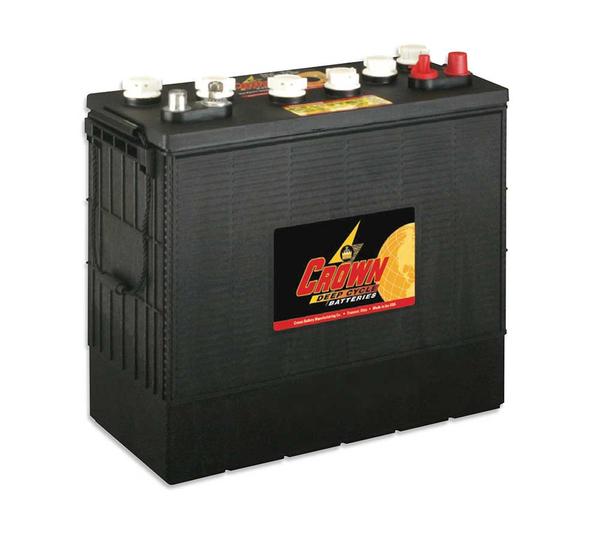
Why did we pick this one? AltE Store deals with many renewable technologies, especially solar panels and their banks. One of their most sold products has to be the Crown Battery- it’s one of their cheapest and most reliable types of battery used for solar power, and you get more than what you pay for. Check out our guide on how to charge 12V batteries with 24V solar panels.
What are users saying about this product?
Durability- AltE Store provides the power bank with a thick frame and a grid-like design that provides physical and structural integrity so that the life of the product is maximized as much as it can be.
The grid-like design provides more surface area within the plate core to output a minimized exposure to electrolyte which, in short terms, reduces corrosion.
The high density lead oxide that’s coated on the interior plates makes for a battery with an even greater durability which, simply, makes for a longer battery life.
Electrical efficiency- Improved electrical efficiency and current flow higher during charging and discharging of the battery with the centerline plate lug
Maintenance- The company recommends that the power bank if charged starting from sunrise, should be fully charged by late morning to early afternoon with the solar panels that are attached to the top of the RV. Check out our guide to learn how many watts from a solar panel it takes to charge a 12V battery.
After charging, the battery should sit for a few hours during the afternoon until the early evening times. A discharge phase should ideally take place during the evening and throughout the night, and the process should repeat when sunrise comes around- this is to ensure that batteries live their longest life.
Weekly check-ups- Since we’re dealing with a flooded lead-acid battery, there should be weekly check-ups that are conducted to measure and confirm the proper water levels of the battery (only after the battery is fully charged).
If the water level is too low, the user should add water before charging- this process makes the maintenance of the product a little more than other types of batteries, but if you don’t mind doing a simple check-up, this product is a steal.
Why did we pick this one? Sold by the same company, AltE Stores, this flooded lead acid deep-cycle battery is a recent addition to high-quality flooded batteries.
With it being one of their most expensive batteries on sale on their website, the price is, to a lot of people, well worth it. Everything about this battery is as premium and upgraded as it gets- if you’re looking for a battery that will most likely last you for many years, you’re looking in the right place.
Having a length of a little more than two feet and the width of a little under a foot, and a height of two feet, it weighs in at around 465 lbs when fully charged- it’s one of the heaviest batteries out there with how much power it can hold and produce for RV.
What are users saying about this product?
Depth of Discharge- Usually with a product, the more of a battery that you drain leads to lesser efficiency- with the Trojan battery, even if you deplete the battery completely every time you use it, it will still last for well over a thousand uses and cycles.
In other words, if you use this battery every single day while only using a depth-of-discharge of 25 percent, it’ll last you well over two years!
Efficiency- Batteries from other companies can have the same capacity and the same energy content, and even, the same weight, but those batteries will still be different from how long the battery will last you due to the material, design, quality control, and process of manufacturing.
When compared to other, similar-sized batteries from other companies, the Trojan battery lasts about twice the total life cycle as other batteries.
Emergency stock- Since there’s a lot of premium materials and upgraded technology being used while manufacturing the battery, it also comes with a back-up battery for emergency uses which is a great feature for anyone that has generated electricity through a solar panel, but maybe there were more clouds that day or if it rained and you couldn’t get enough electricity generated.
The smart grid peak shifting systems also allows the battery to adapt to whatever devices that are hooked up to the battery- this allows more life of battery to be conserved and to be used for other uses. With the output being so high and fast, the price sounds like it is well worth it.
What To Consider When Shopping
Now that we’ve discussed our top picks for batteries, there might’ve been many terms within the descriptions of the products that some people don’t understand. If you’re wanting to go in-depth with the terminology, keep on reading as we will discuss and explain these terms closely.
The big question still remains though- what do we look for when picking out the most ideal RV battery?
There are many factors that go into consideration when picking out the most ideal RV battery for your vehicle. Some factors are common, others are unheard of, but the ones that truly matter might influence a decision of purchase more than other hidden factors such as cost and overall efficiency.
THE DEPTH OF DISCHARGE
The depth of discharge, some might argue, is one of the most important factors when it comes to purchasing an RV battery. The depth of discharge, also known as DoD, indicates the percentage of battery that has been discharged compared to the overall capacity of the battery.
As an example, if you have a battery that holds around ten kilowatt-hours of electricity, and you output nine kilowatt-hours, the depth of discharge is 90 percent.
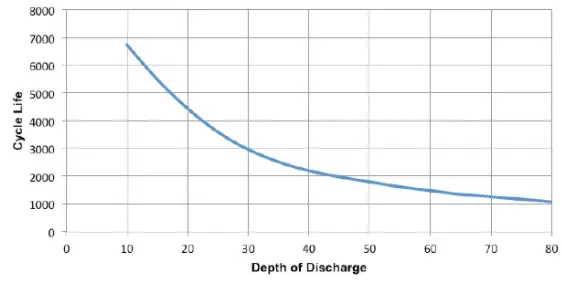
Why does the DoD matter? Well, the more frequently a battery is charged and discharged and charged again, the shorter the battery’s lifespan gets. Even though a phone battery’s percentage goes from 100 to 0 percentage, it’s not recommended that you drain the phone battery fully before recharging it- this will dramatically shorten the life of the battery. Most manufacturers will usually specify a recommended percentage of DoD- most lead acid batteries will be around 20 to 50 percent.
The lifespan is usually determined by the life cycle- for example, a battery may have 10,000 cycles (charging and discharging) with a DoD of ten percent, or you can increase the amount of battery drained to sixty percent and decrease the cycle down to maybe 2,000 cycles.
This is usually the same for your phone’s battery- most manufacturers will recommend using your phone to only a certain percentage and avoiding full depletion at any given time to make the best out of the phone’s battery.
When it comes to charging your phone’s battery or the RV’s battery, a hidden tip and trick is to avoid charging to 100 percent and to, instead, go only up to 80 percent. Think of it like filling up a car’s tires- when a car’s tire is deflated all the way, it’s extremely difficult to even start filling it up; the same goes for a battery.
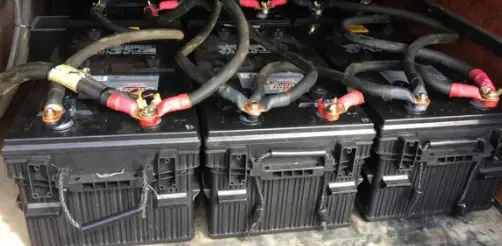
There’s a lot more power that goes into charging the first 20 to 30 percent of a battery. Same goes for when you get beyond 80 percent- with a car, the tire wants to push out air the more you inflate it and reach its limits. You only want to charge up a battery to around 80 percent most of the time, but don’t let me stop you from charging it all the way! Sometimes, it’s necessary, depending on how long the vacation will last!
The biggest takeaway here would be that no matter what kind of battery you purchase, whether it be a phone battery or an RV battery, you should never discharge a battery fully- try to use less than 50% of a battery before recharging.
ROUND TRIP EFFICIENCY
With battery storage, this term is very popular amongst campers who are interested in the specifications and other details about batteries as it defines how much electricity and power you can get from a battery.
Round trip efficiency is the ratio between how much power the battery outputs compared to the amount of power that went into the battery. If the round trip efficiency of a battery is 80 percent, for every 100 kilowatt-hours of electricity that you input, or charge, into the battery, there will be around 80 kilowatt-hours of electricity that gets produced.
This term is useful for determining how much solar power efficiency that the user can transform into usable battery life. The round trip efficiency and the depth of discharge go hand-in-hand- this is where things get complicated.
A battery can have an extremely high round trip efficiency, but that is only relative to the charging and discharging rates of the battery. The depth of discharge can be low which would make the round trip efficiency even lower and less important because that directly impacts how long the battery will last on a long-term basis.
POWER AT LOW AND HIGH TEMPERATURES
A lot of environmental effects can impact a battery discharging rate and amount, but the most effective factor would be the temperature.
Just like human beings, a battery functions the best at room temperature. Some scientific evidence supports that if you warm up a dying battery just a bit, around 80 degrees Fahrenheit, you can squeeze out some more battery life out of it, but while warming up the battery improves the performance, it might negatively shorten the overall lifespan of the battery.
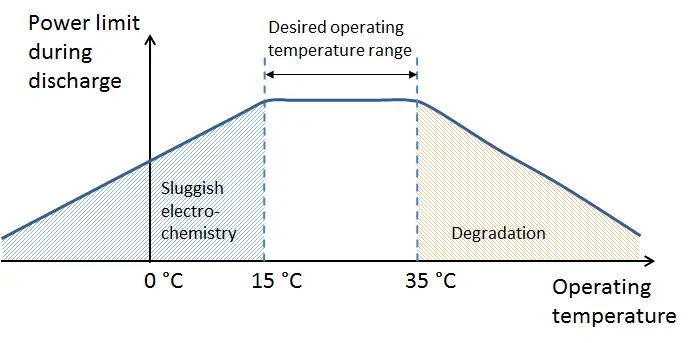
You might’ve noticed that your car’s battery is a little harder to turn on during the winter- that’s because batteries perform worse during cold, harsh environments. This is why you have to let a car sit idle for a few minutes before driving in the winters.
The colder you get, the worse that the battery functions- in fact, during extremely frigid arctic blasts during winter, if the temperature is to fall below -40 degrees Fahrenheit, with lead-acid batteries, there is a massive risk of electrolyte freezing which can crack the enclosure that the heart of the battery sits in. This can cause permanent damage to the battery, and repairing it might cost more than replacing it.
As far as our current technology limits us, it’s only better and safer to use a battery at room temperature, or slightly above, to prevent any harm to the total life cycle of the battery.
ABILITY TO WITHSTAND VIBRATIONS
Imagine you’re cruising down the smooth interstate, but now you have to take an exit or a backroad to get to your camping spot, now and all of a sudden, you’ve gone from a smooth interstate that you were traveling to a rough, bumpy, gravel road- not ideal for your luggage, especially your battery.
Batteries, nowadays, are meant to be able to stand some roughhousing- some batteries come with an extra coat of padding which usually adds cost, weight, and sometimes, resistance to the output of power. A factor that a lot of buyers have to consider is how much wiggling the battery will do and what it’ll do to the battery.
A sudden collision is obviously going to cause massive damage to the battery, but sometimes, all it takes for a battery to leak is a good hit in the right spot, and all of the sudden, your battery is out of use and must be repaired or replaced.

If you know that you’re going to be driving over rough terrain for an elongated period of time, I’d recommend buying a strong, more durable battery so that it can take some minor hits and still function perfectly fine.
If the conditions of the road aren’t going to be that rough, an extra step to ensuring the protection of your battery is to just put some simple padding around where you store your battery- be careful though! Read the manual for any warnings or caution for flammable areas of the battery.
WEIGHT & SIZE
When it comes to batteries, usually, the more power they can store, the bigger and heavier the batteries are- this comes as no surprise. Even though the electrons flowing inside that create electricity have negligible weight, it takes more material and space to hold more electricity.
To some, this is a big factor since some people might not want that big of a load or if weight is going to be a major concern for some campers. Usually, the heaviest that a portable solar RV battery gets is around 40 to 50 lbs, but some car batteries can be heavier than that.
The latest technology is figuring out how to fit more inside of less- manufacturers and engineers are now able to fit a lot of power and electricity inside lighter batteries in order for the batteries to be more efficient while saving money on material and saving the hassle on sizing and any weight issues.
If size is an issue or a big factor when it comes to buying a battery for you, I’d suggest reading more into the batteries that had the feature of unlimited mounting positions from the recommended products- that way, you don’t have to move around a bunch of cargo and try to squeeze the battery into a location where it’s too tight or has the potential to cause damage to the battery.
BATTERY TYPES
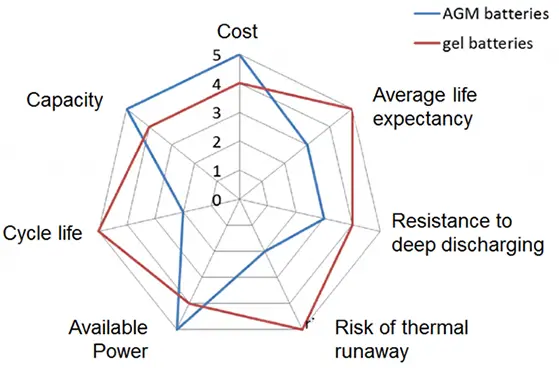
Referenced ISEA
There are many other types of batteries in the market, currently- we’ve already talked about many in the “best batteries to buy” portion of this article. The terminology on some of the battery types is a little bit confusing, so let’s break it down some more.
Deep Cycle Gel
When it comes to renewable energy, such as solar batteries, deep cycle batteries are usually the first to come to mind. Deep cycle gel batteries are energy storage units inside which a chemical reaction happens that makes voltage which results in electricity. These batteries’ design is to cycle and recycle- charge, discharge, and recharge- many times, over and over again.
Usually, these types of batteries are different from a car battery’s- the battery inside of a car is designed to deliver short bursts of power and electricity for a short period of time whereas a deep cycle gel battery provides energy at a steady rate over a long period.
There are many different types of batteries within this genre such as flooded lead-acid batteries, AGM batteries (Absorbed Glass Mat), and more recently with technology, lithium-ion. Let’s talk more about these batteries in depth!
AGM
AGM, when it comes to the types of batteries that are available to consumers, stands for Absorbed Glass Mat. An AGM battery consists of a special glass mat separator that absorbs and draws off the electrolyte mixture that is between the battery plates.
The design of the battery enables the fiberglass to be filled and saturated with electrolytes- this is done to store the electrolytes in a rather suspended state than in free liquid form.
As the battery charges and discharges electricity and power, electrolytes are transferred from the absorbed glass mat to battery plates- the mat contains enough electrolytes for the battery to output at its full capacity and if the battery casing is ever damaged or the seals are broken, the electrolytes aren’t going to spill due to this additional safety hazard feature.
One of the pros about AGM batteries is that they’re often referred to as “maintenance-free” because of the lack of additional watering needing to be done weekly. This is beneficial to those who put the batteries in a location where weekly maintenance can be hard to achieve or for those who just don’t want to take the time every week or so to add some additional water into the battery.
With as great as AGM batteries sound, there are some bad sides to the product as well. Since AGM batteries are made to last longer without maintenance, there is a limited amount of depth of discharge that the user must know about. Because the performance and the capacity of the battery are tweaked and limited, most manufacturers will recommend a depth of discharge of about 50 percent- for example, if your battery can only hold 10 kilowatt-hours of power, the recommended amount you should use should be five kilowatt-hours in order to shoot for the maximum lifespan of the battery.
Flood lead acid
Flood lead acid batteries are the most traditional type of batteries that a user can get- wet, or “flooded,” batteries copy the designs of the original battery. These batteries consist of a variety of combinations of fast-moving, liquid electrolytes. This liquid mixture inside of these batteries must be very carefully measured and be given the most maintenance in order for the battery to perform properly and to reach its maximum lifespan.
The pros? Wet cell batteries are usually one of the best choices for any sort of back-power. If your first battery dies out on you- maybe you thought it was more charged than it was in reality- or if you happen to damage the primary battery, switching over to a reliable wet cell battery would be your best bet since it provides a lot of power and electricity in general, being the most traditional battery there is.
Most of the cons come from taking care of the battery- the flood lead acid batteries require care and periodic inspections because of the free liquid that is inside of the cells.
Something else to consider is that any sort of damage on these types of batteries will most likely cause a leak or cause the battery to malfunction since it is fragile in some ways.
Also due to the liquid, in harsh climates and environments, the liquid inside of the batteries is subject to evaporation or freezing which can be an issue depending on where you choose to camp or travel.
I know that this may seem like a lot of cons, but one thing you have to know about flood lead-acid batteries is that if you add and maintain the water level inside the batteries weekly and do periodic inspections- which only take a couple of minutes- wet cell batteries can last much longer than other types of batteries, short-term and long-term, making them one of the best batteries to be in the market for your RV.
Lithium-ion Batteries
Lithium-ion batteries are the newest of the new in the latest technology regarding energy storage. The battery is a low maintenance storage unit that has no scheduled cycling, memory, and maintenance required that could extend the life of the battery.
The energy density- the ratio of the energy output compared to the area of manufacturing and space- of lithium-ion is around twice that of the standard nickel-cadmium batteries- on top of that, the self-discharge, the output of energy that happens while the batteries sit there idly, with no use, is half that of nickel-cadmium batteries which makes lithium-ion batteries the superior choice in modern days.
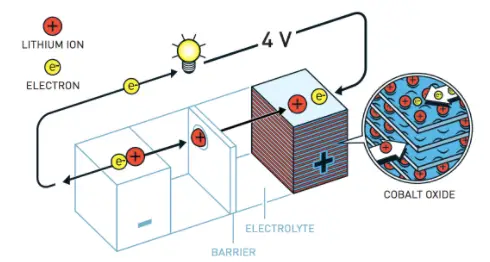
What are some drawbacks? Well, there weren’t any at first, but aging is an issue that most manufacturers are quiet about. After a year or two of making the lithium-ion battery, users and producers start to see capacity deterioration- now, you may be thinking that it’s because of the heavy usage of the batteries that causes the deterioration, but actually, the batteries lose their capacity space even if the batteries have never been used or touched. This comes from the chemical imbalances that occur when different environments are exposed to the batteries.
In some cases, lithium-ion batteries fail after two or three years- in some scenarios, packs of batteries have been known to serve for five years in some applications. If you spend a lot of money, we’re talking thousands of dollars for batteries, for it to only last you two years is not ideal and will leave some users angry. But don’t let this stop you from buying lithium-ion batteries.
The other great things about lithium-ion batteries are that one regular charge is all you need- no more need for prolonged priming when it’s brand new. They also serve great for high current applications such as power tools- you don’t only have to use it for charging your phone or laptop.
Some limitations are set into play, however. Lithium-ion batteries require a little piece of protection circuit to maintain voltage and current within the safe limits of usage. In small packs, the batteries serve no restrictions, but in a bigger, industrialized transportation, shipments of larger quantities may be subject to timely and regulatory check-ups.
Even though they contain more energy density and half of the self-discharge of nickel-cadmium batteries, lithium-ion batteries cost about 40 percent more to manufacture. Lastly, going back to the first issue at hand, these batteries are constantly changing and maturing. The metals and chemicals are constantly being introduced to new environments which isn’t a bad thing, but users don’t know if the best lithium-ion batteries came to be a while back or if they haven’t peaked yet.
But manufacturers haven’t given up any hope or effort. Every half a year, newer and more enhanced chemical combinations are being spit out at a rapid pace- so quick that quality assurance departments are having trouble trying to assess how well the revised batteries will age. This showcases lithium-ion batteries to be superior in many cases and applications.
Eco friendly
After a long hour of a good workout at the gym, your muscles get sore- so you get home and drink a protein shake; why? Because you know that proteins are known for their ability to kickstart muscle-regeneration.
Manufacturers and biologists want to take this a step further- they predict that protein may also be a viable substitute for conventional lithium-ion batteries due to protein’s ability to build and support sustainable organic material.

Why would protein be better than using traditional lithium-ion batteries?
Renewable batteries are eco-friendly and help with the energy and environmental crisis that we are facing today- the protein will substitute lithium-ion without their dangerous safety and toxic environmental concerns and issues.
Right now, there’s no place to throw away lithium-ion batteries, so they end up in landfills which causes harm to the environment. Recycling these batteries is possible, but the cost of recycling is more than manufacturing them from scratch, so there’s no safe, efficient way of getting rid of them- using protein-based batteries would change the game in this situation.
The most important part would be to see how they convert organic material to create energy and how efficient it would be. Biologists suggest that they’d be using synthetic polypeptides- which make up protein- to trigger the movement of electrons which creates electricity in a sense. The only problem is that the protein would need to trigger a lot of electrons in order to be proficient in creating renewable, protein-based electricity.
While this is the early stage, over the next few years, we could see this protein-based power, a new contender in the renewable energy market, come to play. So far, biologists have been testing its functionality compared to other batteries, and they conclude that as far as organic-based batteries go, the structure and flexibility that protein can provide shows wide potential for sustainable, clean energy storage that is safer and reliable for the future.
FAQ
There’s a lot of unanswered questions out there about the right kinds of batteries or just simple questions about the terminology. Let’s discuss the most commonly asked questions and talk about some terminology without going into too much depth.
What is an RV deep cycle battery?
For weekends, getaways, or vacations, taking a camper or an RV to your spot is one of the best feelings, but there is one thing you need to confirm about the camper or the RV- to see if its battery is powered up and ready for the road.
However, RVs and other motorhomes require a special type of battery, specifically designed to be able to draw power over a long period of time continuously but slowly while the engine is shut off. That’s why a deep cycle battery comes into play- it is a special type of battery that’s different from the battery that usually powers the engine to the RV.
A deep cycle battery might be mandatory in order to go off-grid to charge your phone or laptop or to blast your cool air conditioning on hot, summer nights.
Being off-grid means to be disconnected from public utilities and to rely solely on fossil fuel generated power or renewable energy such as solar panels.
Sometimes, a starter battery is needed to kickstart the RV’s engine, but it’s not designed for continued use of reliable power as starter batteries are only designed to provide short, but massive, bursts of energy to only start the RV’s engine.
To learn the difference between normal and deep cycle batteries, check out our guide here.
Do I need two batteries in an RV
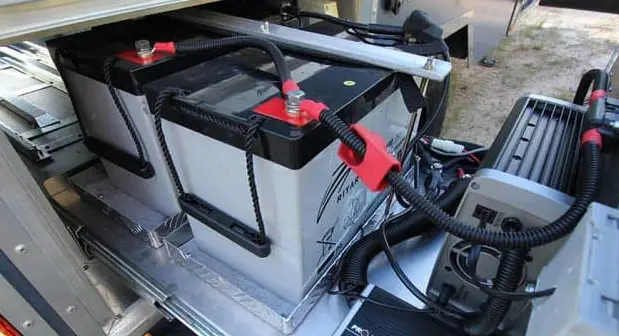
If you already have a starter battery for your RV along with a 12V deep cycle battery, you might be okay for a night or two depending on how many devices you have connected to the battery. But if you’re intending to be off-grid for a while or having a lot of devices being powered at once, you might be better off with two batteries.
Usually, about 50 percent of the people that have an RV buy just one 12V battery as they don’t bring too many electronics along with them, but some that have a class A motorhome- a nicer or a newer RV- they usually end up buying either two batteries or a really nice, expensive battery that’ll last them some time.
The point of camping and leaving your house, to some, is to sit back, relax, and enjoy some time in nature. There’s no point in leaving the television in your house to watch the television in your RV hundreds of miles away from your house unless you’re bored and you just want to kick back and relax after a long day of hiking, but if you do, make sure you’ve got the right battery to stay on top of the game.
Your deep cycle RV battery is specifically designed to provide power at a continuous rate to different devices such as your cell phone charger, your television, your air condition, etc.- there are so many possibilities to a great getaway weekend! Just make sure you prepare for it well and have enough electricity off-grid for you and the people you’ll be camping or vacationing with.
What is the best charger for the RV battery
Manufacturers have made a lot of ways to charge an RV battery, but some are outdated and old- in fact, so old, that the ways to charge and discharge the batteries might result in an electric shock. Let’s talk about some good and bad ways to charge the batteries, so we can familiarize ourselves with the good chargers and stay away from the bad ones.
Converter-chargers are one of the most basic charging systems that convert around 120V of power into 12V of direct current power. The converter is smooth and rated in Amps- around 50 Amps of direct current can power up the entirety of the RV lighting/appliances and even some charging of phones and other devices, too. Inverters work almost the same, but they’re newer and usually found in nicer RVs.
In this article, we’ve mainly talked about solar RVs, so the best way to charge a solar RV’s battery would be to charge it with solar panels. They’re a great option for charging when on the road or away from public utilities, but they need a long time of charging for a smaller round of power than traditional batteries. Some smaller panels can even make up for the self-discharging of batteries that happens when the batteries are on standby.
Solar panels do take a lot of careful planning and installation, so you might need the help of a professional. Wind chargers, on the other hand, might be beneficial if you’re not a “fan” of solar energy! These aren’t as popular because they provide the least amount of power out of every other way of charging due to its small propeller size, but for emergency power when there is a lot of wind or if you’re driving, it can be useful in some scenarios.
Last, but not least, we have to talk about generators. Able to be bought from any store, these chargers can power an entire RV and have enough power to recharge any depleted batteries- but not completely. It is also a bit risky to power the battery directly from the generator- if you, for some reason, forget to turn off the generator when the charge is finished, you may run into some electrical shocks and failures which can be dangerous.
To learn more about the different ways to charge your battery, check out our guide here.
How to charge an RV battery with solar panels
There is a very simple process from turning the sun’s rays and solar energy into electricity to be used to turn on the electrical devices inside of an RV or camper. However, it can be an expensive process due to how many solar panels, tools, components, and installation processes are used.
Don’t let others confuse or trick you- there’s many advantages of using solar power, and the end results can be potentially more beneficial than other methods of charging batteries.
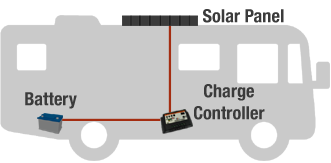
When solar rays hit the solar panels, it has to be a direct, perpendicular hit for it to be at maximum benefit to the user. After hitting the panels, the solar rays, with DC power, travel straight to the solar batteries to be stored- the power cannot be used yet. To be used, the power must travel to a fuse block that travels to an inverter that transforms DC power to usable AC power.
The power then transfers to a transfer switch. From the transfer switch, the power can either go to an outlet to be used in electrical devices, or the power can go to a battery converter charger that transforms AC power back into DC power which returns back to the batteries to be recycled and reused again.
This process is expensive but beneficial- there are many costly equipment that take up time and space to set up, but once it’s all good to go, the power you receive is simple, clean energy that’s renewable as long as the sun shines.
How long does an RV battery last
One of the first concerns that most campers will have is “how long can my RV battery last me?”
To have working lights, refrigerated food, filtered and running water, air conditioning, heat, and entertainment systems, you need some form of electricity, doesn’t matter where you get it from. For most, currently, that power comes from batteries.

When buying a battery for your RV, it all depends on how often you go camping or staying in your RV. If you like vacationing once or twice a year, a simple 12V should last you two to three days- if you’re camping for a little longer, maybe buying two batteries might not hurt.
If you’re a go-getter that spends vacation time in their RV more than four or five times a year, I’d suggest buying a bigger, more expensive battery- it’ll save you money and effort in the long run. You can enjoy electricity in bulk while staying worry-free of going without air conditioning on hot, summer days, or going without heating on cool, winter nights.
While watts and watt-hours are more commonly used in the title of batteries, using Amp hours, or Ah, can be more convenient when talking about how long a battery is supposed to last the user. For example, if a 12V lamp has a draw of one Amp, leaving the lamp on for an hour will consume 1 Amp hour of battery power. If you leave the lamp on for two hours, it will have consumed two Amp hours of battery power- and so on.
Under the most average conditions of usage- using lights, a fridge, charging phones and laptops, a water pump- a 12V battery should be enough to last a person two to three days. By conserving electricity- shutting off lights when not in use, not running the water pump when unneeded- the time can be extended. Even better, by taking care of your batteries, it’ll last longer that way.
A typical deep cycle RV battery is rated around 80 Amp hours which would, in theory, provide enough electricity to power one Amp for around 80 hours, but in reality, depending on how well you’ve been taking care of your battery, what the depth of discharge rate is, what the self-discharge rate is, it can shorten that 80 hours to a mere 40 to 50 hours.
A very simple calculation with watt-hours can tell you exactly how long your battery will last you. Let’s say you’ve got a TV that runs on 100 watts, and your power source has got a rating of around 480 watt-hours. If you take the 480 watt-hours and divide it by the 100 watts, you’ll be left with, theoretically, 4.8 hours of watch time on that one battery.
Keep in mind though- resistance, maintenance, inefficiencies, and other factors may affect the output, but it’s a good formula for estimating how many batteries you’ll need or how long you can go with just a simple 12V battery.
How can I extend the life of my RV batteries
Taking care of a battery can be simple at times and difficult with other batteries- properly maintained deep cycle batteries should last for around six years, sometimes more, but sometimes, RV owners are found replacing their batteries after only two years. Here are some simple, yet effective, tips to extend the life of the batteries.
Try to only use 20% of the battery after a full charge. This sounds hard, but doing this will stop the chances of sulfation which is a process where small crystals start forming on plates if the battery falls below 80% capacity. Sulfation, over an extended time, can ruin and destroy a battery easily if left untreated- this is one of the main reasons why many RV owners are replacing their batteries after only two years.
Don't Overcharge Your Battery
Overcharging can kill a battery if you’ve got a lead-acid battery. By unplugging and stopping the charging of the battery can help extend the battery life.
If you’ve a lead-acid battery, be sure to check the electrolyte level every single week. If it’s too low, add water to save the lead-acid batteries.
When adding water, make sure to use mineral-free water, so that none of the minerals react negatively with the materials in the battery’s cells and cause calcium sulfation. Distilled water works the best!
Batteries should only be watered after charging. There is an exception- don’t water the batteries if the plates are exposed prior to charging. If the plates are exposed, just go ahead and add enough distilled water to cover the plates and, then, charge the battery. When the battery is fully charged, fill each of the cells to the bottom of the vent wall.
Wrap Up
There is a lot that goes into finding the perfect RV battery for yourself which isn’t a bad thing!
There’s a lot of money that goes into purchasing an RV battery. Buying a battery is one thing, but taking care of one is something a lot of users forget about which causes their batteries to only last a few years; a lot less than it would if the user was to properly take care of the battery.
If you’re a camper who’s invested a lot of money into their RV or camper/motorhome, you’re more likely to want a good battery that’ll last you several years without giving you much problems. A good, concluding rule of thumb would be to invest for the long run- it’s better to spend a little more money now rather than regretting it when your air conditioning turns off in the middle of the night in your camper, you can’t sleep, and you stay up regretting your decision with the batteries.
Trust me, motorhomes are fun when vacationing! This isn’t to scare buyers into recklessly spending unnecessary amounts of money into a product- this is just a helpful guide for some people who are looking for a quick description of the product, and others who are wanting to go more in-depth with how they purchase their batteries.
Just make sure that you and your camping associates get the most out of it while staying safe and clean!

